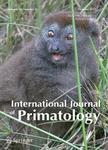版权所有:内蒙古大学图书馆 技术提供:维普资讯• 智图
内蒙古自治区呼和浩特市赛罕区大学西街235号 邮编: 010021

作者机构:Chinese Acad Sci Inst Zool Key Lab Anim Ecol & Conservat Biol Beijing 100080 Peoples R China Guangxi Normal Univ Coll Life Sci Guilin 541004 Guangxi Peoples R China Chinese Acad Sci Grad Sch Beijing 100049 Peoples R China
出 版 物:《INTERNATIONAL JOURNAL OF PRIMATOLOGY》
年 卷 期:2006年第27卷第5期
页 面:1441-1460页
核心收录:
学科分类:0710[理学-生物学] 07[理学] 071002[理学-动物学]
主 题:diet food choice Francois' langur phenology Trachypithecus francoisi
摘 要:We studied the diet and food choice of 1 group of Francois langurs (Trachypithecus francoisi) from August 2003 to July 2004 in the Nonggang Nature Reserve, Guangxi province, China. The langurs consumed 90 plant species, including 14 unidentified species. Leaves constituted 52.8% of the diet (38.9% young leaves and 13.9% mature leaves). Fruits and seeds accounted for 17.2% and 14.2%, respectively. Flowers and other items-including petioles, stems, roots, and bark-contributed to 7.5% and 7.4% of the diet, respectively. The langur diet varied according to season. They fed on more young leaves from April to September. Consumption of seeds, petioles, and stems increased between October and March, when young leaves were scarce. The diet shift corresponded to higher dietary diversity during the young leaf-lean period. Though the langurs fed on many plant species, 10 species accounted for 62.2% of the diet, only 2 of which were among the 10 most common tree species in vegetation quadrants, and the percentage of feeding records on a plant species and the percentage of individuals of the species in vegetation quadrants does not correlate significantly. Francois langurs fed selectively, and they did not base their diet simply on the abundance of plant species in the habitat.